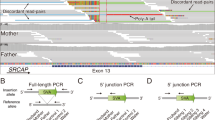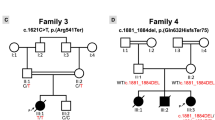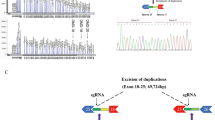Abstract
Fukuyama-type congenital muscular dystrophy (FCMD), one of the most common autosomal recessive disorders in Japan (incidence is 0.7–1.2 per 10,000 births), is characterized by congenital muscular dystrophy associated with brain malformation (micro-polygria) due to a defect in the migration of neurons1. We previously mapped the FCMD gene to a region of less than 100 kilobases which included the marker locus D9S2107 on chromosome 9q31 (2–4). We have also described a haplotype that is shared by more than 80% of FCMD chromosomes, indicating that most chromosomes bearing the FCMD mutation could be derived from a single ancestor5. Here we report that there is a retrotransposal insertion of tandemly repeated sequences within this candidate-gene interval in all FCMD chromosomes carrying the founder haplotype (87%). The inserted sequence is about 3 kilobases long and is located in the 3′ untranslated region of a gene encoding a new 461-amino-acid protein. This gene is expressed in various tissues in normal individuals, but not in FCMD patients who carry the insertion. Two independent point mutations confirm that mutation of this gene is responsible for FCMD. The predicted protein, which we term fukutin, contains an amino-terminal signal sequence, which together with results from transfection experiments suggests that fukutin is a secreted protein. To our knowledge, FCMD is the first human disease to be caused by an ancient retrotransposal integration.
This is a preview of subscription content, access via your institution
Access options
Subscribe to this journal
Receive 51 print issues and online access
$199.00 per year
only $3.90 per issue
Buy this article
- Purchase on Springer Link
- Instant access to full article PDF
Prices may be subject to local taxes which are calculated during checkout





Similar content being viewed by others
References
Fukuyama, Y., Osawa, M. & Suzuki, H. Congenital muscular dystrophy of the Fukuyama type—clinical, genetic and pathological considerations. Brain Dev. 3, 1–30 (1981).
Toda, T. et al. Localization of a gene for Fukuyama type congenital muscular dystrophy to chromosome 9q31-33. Nature Genet. 5, 283–286 (1993).
Toda, T. et al. Refined mapping of a gene responsible for Fukuyama-type congenital muscular dystrophy: evidence for strong linkage disequilibrium. Am. J. Hum. Genet. 55, 946–950 (1994).
Toda, T. et al. Linkage-disequilibrium mapping narrows the Fukuyama-type congenital muscular dystrophy (FCMD) candidate region to <100 kb. Am. J. Hum. Genet. 59, 1313–1320 (1996).
Kobayashi, K. et al. Founder-haplotype analysis in Fukuyama-type congenital muscular dystrophy (FCMD). Hum. Genet. (in the press).
Miyake, M. et al. YAC and cosmid contigs encompassing the Fukuyama-type congenital muscular dystrophy (FCMD) candidate region on 9q31. Genomics 40, 284–293 (1997).
Nakai, K. & Kanehisa, M. Aknowledge base for predicting protein localization sites in eukaryotic cells. Genomics 14, 897–911 (1992).
Hofmann, K. & Stoffel, W. TMbase—A database of membrane spanning protein segments. Biol. Chem. Hoppe Seyler 374, 166 (1993).
Sachs, A. B. Messenger RNA degradation in eukaryotes. Cell 74, 413–421 (1993).
Ervasti, J. M. & Campbell, K. P. Membrane organization of the dystrophin–glycoprotein complex. Cell 66, 1121–1131 (1991).
Campbell, K. P. Three muscular dystrophies: loss of cytoskeleton–extracellular matrix linkage. Cell 80, 675–679 (1995).
Worton, R. Muscular dystrophies: disease of the dystrophin–glycoprotein complex. Science 270, 755–756 (1995).
Matsumura, K., Nonaka, I. & Campbell, K. P. Abnormal expression of dystrophin-associated proteins in Fukuyama-type congenital muscular dystrophy. Lancet 341, 521–522 (1993).
Hayashi, K. Y. et al. Abnormal localization of laminin subunits in muscular dystrophies. J. Neurol. Sci. 119, 53–64 (1993).
Nakano, I., Funahashi, M., Takada, K. & Toda, T. Are beaches in the glia limitans the primary cause of the micropolygria in Fukuyama-type congenital muscular dystrophy (FCMD)?—Pathological study of the cerebral cortex of an FCMD fetus. Acta Neuropathol. 91, 313–321 (1996).
Ishii, H., Hayashi, Y. K., Nonaka, I. & Arahata, K. Electron microscopic examination of basal lamina in Fukuyama congenital muscular dystrophy. Neuromuscul. Disord. 7, 191–197 (1997).
D'Arcangelo, G. et al. Aprotein related to extracellular matrix proteins deleted in the mouse mutant reeler. Nature 374, 719–723 (1995).
Sheldon, M. et al. Scrambler and yotari disrupt the disabled gene and produce a reeler-like phenotype in mice. Nature 389, 730–733 (1997).
Reiner, O. et al. Isolation of a Miller-Dieker lissencephaly gene containing G-protein β-subunit-like repeats. Nature 364, 717–721 (1993).
des Portes, V. et al. Anovel CNS gene required for neuronal migration and involved in X-linked subcortical laminar heterotopia and lisencephaly syndrome. Cell 92, 51–61 (1998).
1. Gleeson, J. G. et al. doublecortin, a brain-specific gene mutated in human X-linked lissencephaly and double cortex syndrome, encodes a putative signaling protein. Cell 92, 63–72 (1998).
Bannai, M. et al. Discrimination of human HLA-DRB1 alleles by PCR-SSCP (single-strand conformation polymorphism) method. Eur. J. Immunogenet. 21, 1–9 (1994).
Acknowledgements
We thank the family members who participated in this study; F. Saito, Y. Sunada, E.Katayama, M. Hino, J. Fujisawa, F. Oyama, I. Nishino, H. Hohjoh, Y. Miki, M. Watanabe, T. Tokino, K.Arahata, Y. Fukuda, J. Inazawa, T. Tanaka and S. Ikegawa for advice; T. Iwata, T. Kumagai, S. Kobayashi, T. Ishihara, K. Suzumori, C. Nakano, S. Sugino, M. Funahashi, Y. Mizuno, H. Muranaka, A. Honma and E.Nanba for samples; J. Goto and N. Tsuji for managing cell lines; and I. Matsushita and K. Takeuchi for technical assistance. This work was supported by grants from the Ministry of Health and Welfare and from the Ministry of Education, Science and Culture, Japan.
Author information
Authors and Affiliations
Corresponding author
Rights and permissions
About this article
Cite this article
Kobayashi, K., Nakahori, Y., Miyake, M. et al. An ancient retrotransposal insertion causes Fukuyama-type congenital muscular dystrophy. Nature 394, 388–392 (1998). https://doi.org/10.1038/28653
Received:
Accepted:
Issue Date:
DOI: https://doi.org/10.1038/28653
This article is cited by
-
Hominoid SVA-lncRNA AK057321 targets human-specific SVA retrotransposons in SCN8A and CDK5RAP2 to initiate neuronal maturation
Communications Biology (2023)
-
Prevalence and founder effect of DRC1 exon 1–4 deletion in Korean patients with primary ciliary dyskinesia
Journal of Human Genetics (2023)
-
Mobile element variation contributes to population-specific genome diversification, gene regulation and disease risk
Nature Genetics (2023)
-
CDP-ribitol prodrug treatment ameliorates ISPD-deficient muscular dystrophy mouse model
Nature Communications (2022)
-
Epidemiology of congenital disorders of glycosylation (CDG)—overview and perspectives
Journal of Rare Diseases (2022)
Comments
By submitting a comment you agree to abide by our Terms and Community Guidelines. If you find something abusive or that does not comply with our terms or guidelines please flag it as inappropriate.



